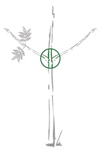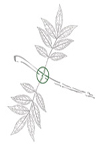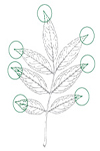






What Are Your Trees Worth?
Almost everyone knows that trees and other living plants are valuable. They beautify our surroundings,
purify our air, act as sound barriers, manufacture precious oxygen, and help us save energy through their
cooling shade in summer and their wind reduction in winter. Many people dont realize, however, that plants
have a dollar value of their own that can be measured by competent plant appraisers. If your trees or shrubs
are damaged or destroyed, you may be able to recapture your loss through an insurance claim or as a deduction
from your federal income tax.
Information on our most common tree trims and removals:

SILVER MAPLE or soft maple (Acer saccharinum)
Form: Large tree, 40' - 70' tall; massive, round-topped crown; trunk, often divided low, up to 42" diameter.
Leaves: Opposite, simple, 4" - 6" long, nearly as wide, palmately lobed; lobes, 5, 2 deeply cut crotches come to sharp point, doubly toothed margins; dull green (white or silvery below); pale yellow to orange in autumn.
Twigs: Yellowish-gray to reddish-brown, disagreeable odor when broken; buds, dark red, blunt.
Fruit: Samara, 1½" - 2½" long, V-shaped pairs with widely divergent wings, mature in spring.
Bark: Gray; smooth; becoming furrowed with long, scaly, narrow strips that often curl at the ends.
Range: Native, southern and east-central Minnesota, north to Duluth and west to upper Mississippi River; hardy to Zone 3b.
Remarks: Moderately shade-intolerant; fast-growing; moderately short-lived. Prolific seed producer commonly found in moist bottomland forests. Sprouts vigorously when injured. Extensively planted as a fast-growing street tree that is somewhat tolerant of extreme site conditions, but has brittle branches and roots that may damage sidewalks, sewers, and drains. Occasionally used for maple syrup.
ASH TREES:

BLACK ASH or (Fraxinus nigra)
Form: Medium-sized tree with a height of 35' to 75', a diameter of 12" to 24"; crown is rounded and made up of a few short branches; trunk is supposed to be straight, columnar, but is often leaning or crooked.
Bark: Grayish on older portions of tree, furrowed and somewhat separated into thin scales that are easily rubbed off; new growth of light green color.
Leaf: Opposite on stem, length 9" to 16", pinnately compound with seven to 11 yellowish-green leaflets each 4" to 5 1/2" long, oblong in shape, and not stalked except the terminal leaflet; terminal bud is large and pointed; leaves smooth on both surfaces; turn yellow to brown in autumn.
Fruit: (seed) Flat, winged, one-seeded samara, 1" to 1 1/2" long; the wide, thin wing that is rounded or slightly notched at the end, nearly surrounds the seed part; seeds usually germinate and start growth in the second year.
Range: Fairly plentiful in the state except in the western half; most abundant in cold, moist locations and along low banks of streams; shade-intolerant, slow-growing.
This slow-growing tree is found throughout Minnesota except in the western prairie, in cool, moist places. Heavy, coarse-grained wood separates into thin layers that can be used for baskets.

GREEN ASH or (Fraxinus pennsylvanica)
Form: Height 40' to 60', up to 24" in diameter; round-topped with slender spreading branches.
Bark: Dark brown or gray, tinged with red; strongly furrowed or ridged.
Leaf: Opposite on stem, length 10" to 12", pinnately compound with seven to nine stalked leaflets each 2 3/4" to 5" long, pointed and slightly toothed on margin; bright green or yellowish-green on both sides, turning yellow in autumn.
Fruit: (seed) Flat, winged samara, 1" to 2" long; winged portion extends well down past middle or seed-bearing part; slightly notched at outer end; wing has a somewhat square appearance.
Range: Common throughout the state except in the western prairie region; most abundant in valleys and along streams; moderately shade-tolerant; fairly fast-growing and will withstand severe conditions of both soil and climate.
This fast-growing tree is found throughout most of Minnesota, often in valleys and along streams. It also is commonly planted as a boulevard tree in Minnesotas communities. Its strong wood is used to make furniture, tool handles, hockey sticks, and other wood products.

WHITE ASH or (Fraxinus americana)
Form: Height 40' to 60', up to 24" in diameter; round-topped with slender spreading branches.
Bark: Dark brown or gray, tinged with red; strongly furrowed or ridged.
Leaf: Opposite on stem, length 10" to 12", pinnately compound with seven to nine stalked leaflets each 2 3/4" to 5" long, pointed and slightly toothed on margin; bright green or yellowish-green on both sides, turning yellow in autumn.
Fruit: (seed) Flat, winged samara, 1" to 2" long; winged portion extends well down past middle or seed-bearing part; slightly notched at outer end; wing has a somewhat square appearance.
Range: Common throughout the state except in the western prairie region; most abundant in valleys and along streams; moderately shade-tolerant; fairly fast-growing and will withstand severe conditions of both soil and climate.
Native to southeastern Minnesota, white ash grows best in rich, moist soil. The wood is strong and elastic. Uses include baseball bats, tool handles, and furniture.
To identify an ash tree, first look for the following:
 Has branches that grow directly across from one another.
Has branches that grow directly across from one another. Has compound leaves(a group of leaflets joined by a stalk to a woody stem.)
Has compound leaves(a group of leaflets joined by a stalk to a woody stem.) Has five to many leaflets with smooth or finely toothed margins.
Has five to many leaflets with smooth or finely toothed margins.OAK TREES:

What are the risk "season" references?
There are three Risk Season timeframes: High Risk, Low Risk and No Risk. They refer to the probability that oak wilt will infect a tree.
- High Risk months in Minnesota are April, May and June.
- Low Risk months are July, August, September and October.
- No Risk months are November, December, January, February and March.
Main Species of Oak Trees:
- Black oak
- Bur oak
- Cherrybark oak
- Laurel oak
- Live oak
- Oregon white oak
- Overcup oak
- Post oak
- Pin oak
- Northern red oak
- Scarlet oak
- Shumard oak
The oak tree family includes as many as 600 species, found chiefly in north temperate zones and also in Polynesia. Oak is the wood for lumber: Oaks are cultivated for ornament and are prized as the major source of hardwood lumber. The wood is durable, tough, and attractively grained; it is especially valued in shipbuilding and construction and for flooring, furniture, railroad ties, barrels, tool handles, and veneer. The bark of some oaks has been used in medicine, in tanning, and for dyes. Acorns, the fruit of oak trees, have long been employed as a source of hog feed, tannin, oil, and especially food. A symbol of strength, the oak has been revered for both historical and mythological associations.
ELM TREES:

Elms are deciduous and semi-deciduous trees comprising the genus Ulmus, family Ulmaceae. Elms first appeared in the Miocene period about
40 million years ago. Originating in what is now central Asia, the tree flourished and established itself over most of the Northern Hemisphere,
traversing the Equator in Indonesia. During the 19th and early 20th centuries, many species and cultivars were planted as ornamentals in Europe,
North America, and parts of the Southern Hemisphere, notably Australasia.
Elm leaves are alternate, with simple, single- or, most commonly, doubly serrate margins, usually asymmetric at the base and acuminate at the apex.
The genus is hermaphroditic, having perfect flowers which, being wind-pollinated, are apetalous. The fruit is a round wind-dispersed samara. All species
are tolerant of a wide range of soils and pH levels but, with few exceptions, demand good drainage.
Pruning is one of the most important ways we can help our trees. Regular removal of dead branches:
- Decreases the breeding area for disease-carrying insects.
- Promotes growth
- Removes safety hazards
- Improves the trees appearance.
Take care of your trees! Improper or untimely pruning can do more harm than good.

PINE TREES:
Pine trees are evergreens with long, needle-shaped leaves. They are widely planted in North America, particularly in northern areas.
Pine trees produce cones for propagation of the species. Pines are coniferous trees and there are more then 100 species of pines world wide.
The United States has about 35 species of pines growing mostly in colder climates. Pines are important trees and are valued for their timber and wood pulp production.
Pine trees are long lived and typically reach ages of 100 years old or more. Most pine trees prefer full sun exposure and require little or no extra water during their full grown stages.
Pines grow well in acidic soils and require good soil drainage. Pine seeds (from the cones) are commonly eaten by birds and squirrels and the seeds are then spread by these wildlife creatures.
Pine trees make attractive ornamental plantings for homeowners and are widely used for windbreaks or privacy screens. Pine trees can look very attractive in the winter landscape. Most pine needles are
green and most tend to appear as darker green and thus display a stark contrast against a dull or white winter landscape. Pine trees are also known for their pleasing smell and are commercially used for winter
and in home Christmas decorations. The cones, pine boughs, and trees all are distinctive and used as Christmas decorations.
Pine Species:
- Austrian Pine Tree
- Colorado Pine Tree
- Cuban Pine
- Foxtail Pine
- Jack Pine
- Japanese Pine Tree
- Loblolly Pine Tree
- Lodgepole Pine Tree
- Mexican Pine Tree
- Norway Pine Tree
- Pitch Pine Tree
- Ponderosa pine
- Scotch Pine Tree
- Spruce Pine Tree
- Sugar Pine Tree
- Tamarack or (Larch)
- Virginia Pine Tree
- Yellow Pine
Facts About Pine Trees:
- The North American Real Christmas Trees are grown in all 50 states of United States and Canada too.
- Pine trees are the only species of trees that reproduce from seeds in a cone.
- They can grow in any soil and anywhere in the world.
- Of the seven continents, pine trees are found to be growing in six continents.
- Fully grown pine trees require full sun and very little water to survive.
- The southern pine tree beetle infests a single tree in thousands at once that makes it one of the most destructive pests.
- Pine trees are ornamental plants and harvested for making lawn decoration and furniture.
- One of the oldest surviving trees on earth is the Great Basin Bristlecone Pine that is over 4,840 years old.

COTTONWOOD or (Populus deltoides var. occidentalis)TREES:
Form: Large tree, 50' to 80' tall, diameter 36" to over 48"; developing first a narrow, conical crown that with maturity becomes broad and open supported by a massive trunk.
Bark: Light gray on young trees and dark gray and rough on older trees.
Leaf: Simple, alternate on stem, 3" to 5" long, nearly as wide; broadly ovate or triangular, pointed, square at base, finely toothed or wavy on edges; covered with soft white hairs on underside; slender stems from 2" to 3" long are flattened; winter buds covered with chestnut-brown, resinous scales; turns yellow to yellowish-orange in autumn.
Fruit: (seed) Two to four, valved, thin capsules borne on short stock in drooping ?catkins?; seeds, when set free in late May or June, are minute, pale, brownish-white, enclosed in a cluster of white cottony hairs that carry them for long distances. There are two kinds of flowers borne separately on different trees; female trees throw cotton.
Range: Found throughout Minnesota, often forming extensive groves; will grow on dry locations but makes most rapid progress on moist sites; shade-intolerant, very fast-growing.
The cottonwood also known as the poplar is a tall tree with a spreading crown, named for its cotton like seeds. The diverse poplar family includes the quaking aspen, which boasts the widest range of any North American tree, and the Plains cottonwood, which was the only tree many early settlers met as they forged westward through America's prairies. Today as in centuries past, the cottonwood offers welcome shade, as its powerful trunk divides into thick branches and opens into a spreading crown. Many cottonwoods grow from 70 to 100 feet tall, and the tree’s quick growth rate and adaptability to many soils and climates have made it an age-old friend to the American people.
Species of Cottonwoods:- Balsam Poplar
- Bigtooth Aspen
- Black Cottonwood
- Eastern Cottonwood
- Fremont Cottonwood
- Lanceleaf Cottonwood
- Lombardy Black Poplar
- Narrowleaf Cottonwood
- Plains Cottonwood
- Quaking Aspen
- White Poplar
© Davison Tree Service 2010